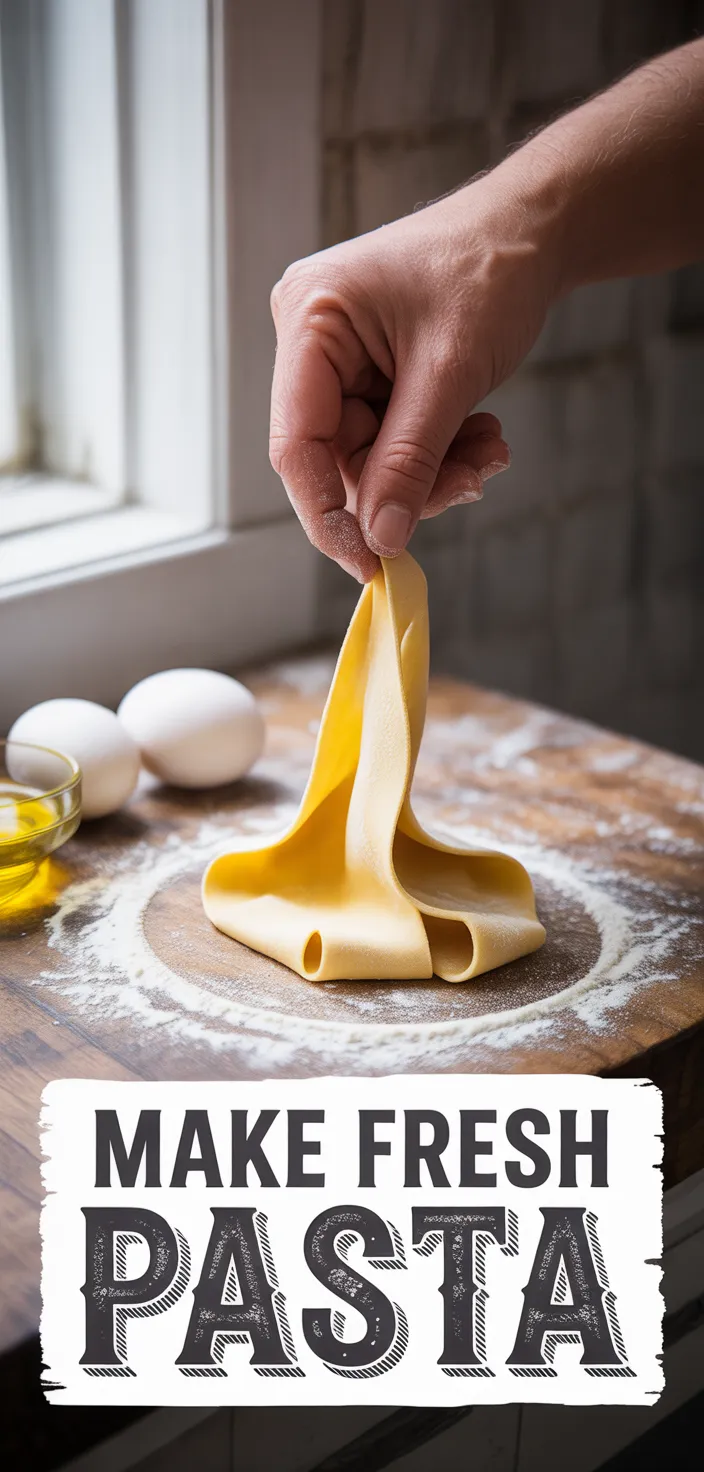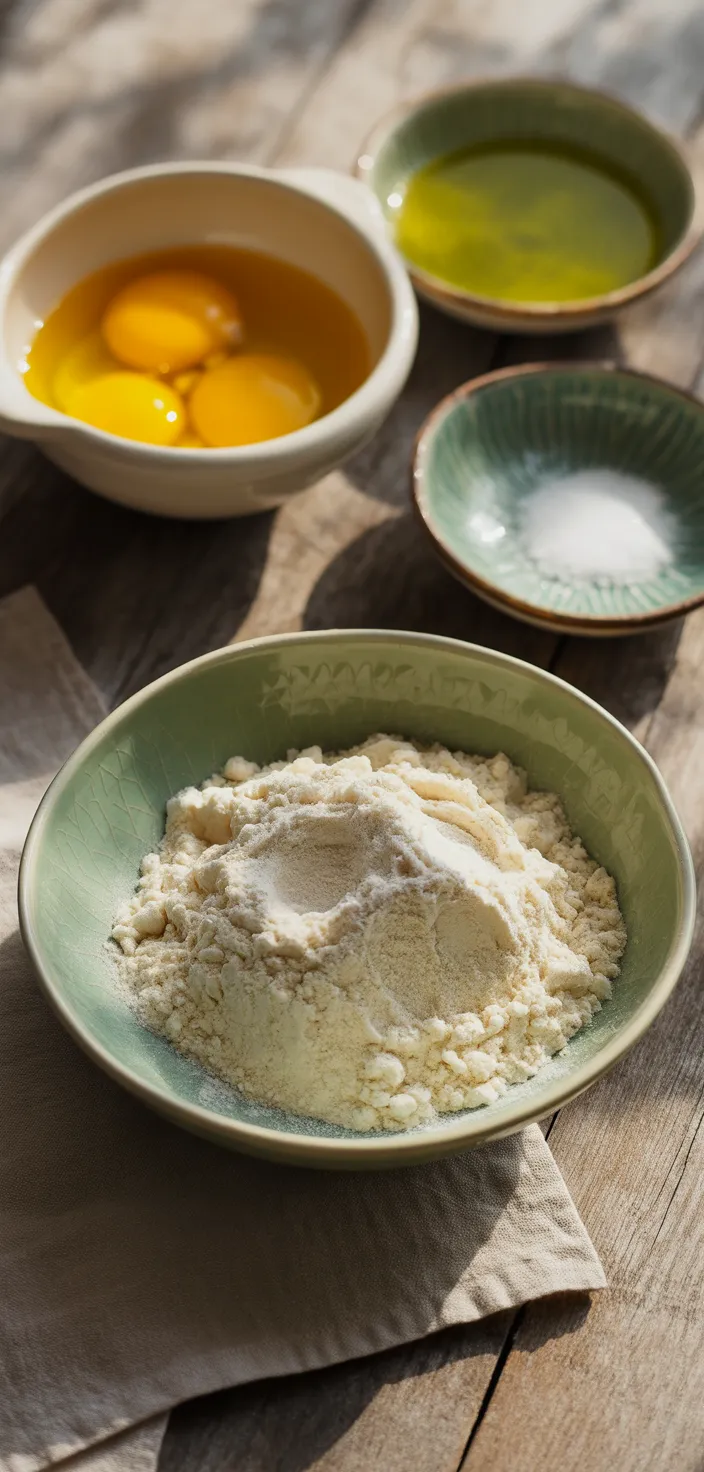I made Easy Homemade Pasta from just four pantry staples and a simple knife cut, no machine required, and the hand-cut noodles look unmistakably homemade.

I’ve always loved the idea of tearing into freshly cut ribbons of pasta you made yourself. Making pasta by hand, with nothing more than ’00’ flour and eggs, feels almost wrong, it’s so simple yet so honest.
This is the sort of Easy Homemade Pasta that makes you question why we ever relied on gadgets. The Homemade Pasta Dough gets a little rough around the edges, and that’s kind of the point because imperfect noodles have personality.
I’ll show the tricks I use so you end up with rustic, hand cut noodles that beg to be eaten right away, warm and a little messy.
Ingredients

How To Make Fresh Homemade Pasta
- Flour: ’00’ or all purpose provides carbs and structure, makes pasta tender yet firm.
- Eggs: add protein, richness, color and bind dough, making it silky and flavorful.
- Extra virgin olive oil: adds fat, smoothness, a bit of flavor and keeps dough supple.
- Sea salt: enhances flavor, balances taste, and slightly strengthens gluten when used right.
Ingredient Quantities
- 400 g ’00’ flour or all purpose flour (about 3 1/3 cups)
- 4 large eggs (about 200 g)
- 1 teaspoon fine sea salt
- 1 tablespoon extra virgin olive oil
How to Make this
1. Put 400 g ’00’ flour or all purpose flour (about 3 1/3 cups) on a clean counter, sprinkle in 1 teaspoon fine sea salt, then make a big well in the middle.
2. Crack 4 large eggs (about 200 g) into the well and add 1 tablespoon extra virgin olive oil. Beat the eggs and oil with a fork, slowly drawing flour from the sides into the center until a shaggy dough forms.
3. Use your hands to bring the dough together, then knead on the counter for about 8 to 10 minutes until it is smooth and elastic. If it feels too sticky sprinkle a little flour, if too dry add a few drops of water. Don’t overdo either one.
4. Shape the dough into a tight ball, wrap it in cling film or cover with an inverted bowl and let it rest at room temperature for 30 minutes so the gluten relaxes.
5. Cut the rested dough into 4 pieces, keep the pieces you’re not working with covered so they don’t dry out.
6. Take one piece and flatten it with your palm, then roll it out with a rolling pin. Turn and flip often, roll until nearly translucent or about 1 to 2 millimeters thick depending on how thin you want it. Remember fresh pasta needs to be thin or it will be doughy when cooked.
7. Lightly flour the sheet, loosely roll it up from the short side like a cigar and slice with a sharp knife to make ribbons for tagliatelle or fettuccine. Unroll the ribbons and toss them lightly in flour so they don’t stick together.
8. If you want shapes other than ribbons, fold once or twice and cut wider or narrower, or cut straight sheets to use as lasagna. Use a bench scraper to help lift and separate pieces if needed.
9. Bring a large pot of well salted water to a rolling boil, add the fresh pasta and stir gently so it doesn’t clump. Fresh pasta cooks very fast, usually 2 to 4 minutes depending on thickness, taste test early. Save a cup of cooking water before draining.
10. Drain quickly, then toss with your sauce or just olive oil and a little of the reserved pasta water to loosen and help the sauce cling. Serve immediately, it’s best eaten right away.
Equipment Needed
1. Digital kitchen scale (or measuring cups) — for accurate 400 g flour and eggs, scales are best but cups work too.
2. Clean work surface or large counter space to mix and knead the dough, you need room to roll.
3. Fork — to beat the eggs and oil in the flour well, simple but essential.
4. Rolling pin for thinning sheets until nearly translucent, roll, turn and flip often.
5. Sharp chef knife or pasta cutter to slice ribbons (tagliatelle or fettuccine) neatly.
6. Bench scraper to lift, divide and help handle sticky dough pieces.
7. Plastic wrap or an inverted bowl to cover the dough while it rests so it won’t dry out.
8. Large pot and colander plus a wooden spoon or pasta server to cook, stir and drain the fresh pasta.
FAQ
How To Make Fresh Homemade Pasta Recipe Substitutions and Variations
How To Make Fresh Homemade Pasta
- 400 g ’00’ flour or all purpose flour (about 3 1/3 cups)
- 4 large eggs (about 200 g)
- 1 teaspoon fine sea salt
- 1 tablespoon extra virgin olive oil
Short bit before we start: This is simple, honest pasta. It takes a little elbow grease but you get silkier, fresher noodles than store-bought. Don’t stress if your first sheet is uneven, it happens to everyone.
Method
1. Mound the flour on a clean counter and make a big well in the middle, like a little volcano. Crack the eggs into the well, add the salt and olive oil.
2. Use a fork to beat the eggs gently, then start pulling in flour from the inner wall of the well. Go slow so the wall doesn’t break. When it gets too stiff to mix with the fork, use your hands.
3. Once it mostly comes together, knead it by hand for about 8 to 10 minutes until the dough is smooth and elastic. If it’s sticky add a light dusting of flour, if it’s dry add a teaspoon or two of water. Don’t overdo either.
4. Shape into a ball, wrap in plastic or cover with a bowl and let rest at room temp for 30 minutes. This relaxes the gluten and makes rolling easier.
5. Cut dough into 4 pieces. Flatten one piece with your palm, then run it through a pasta machine from the widest setting down to thinner settings, dusting with flour as needed. If you don’t have a machine, roll it thin with a rolling pin until almost translucent.
6. Cut into whatever shape you want: tagliatelle, fettuccine, pappardelle or use for stuffed pasta. Hang strips on a rack or lay on a floured tray while you do the rest.
7. To cook, bring a large pot of salted water to a boil. Fresh pasta cooks fast, usually 1 to 3 minutes depending on thickness. Taste for doneness.
8. Drain and toss immediately with sauce, olive oil, butter, or whatever you like. Fresh pasta soaks up sauce fast, so serve right away.
Tips and tricks
– Resting is not optional, it really helps the dough relax so you can roll it thin without snapping back.
– If dough feels rubbery after kneading, give it another 5 minutes of knead, sometimes you just need to work it.
– Keep flour handy but use it sparingly, too much makes the pasta dry.
– If you want silkier pasta, use only egg yolks for a richer dough, but you’ll need to adjust liquid. Or if you prefer toothy pasta for sauces, add a bit of semolina.
Substitutions
- Flour: Use semolina (durum) 1:1 by weight for a firmer, slightly grittier bite. Good for shapes and holds sauce well.
- Eggs: Use aquafaba (chickpea brine) 3 tbsp (45 ml) per large egg. For this recipe use about 180 ml aquafaba for 4 eggs, makes eggless pasta.
- Olive oil: Swap with melted unsalted butter or a neutral oil like grapeseed at 1:1 for same fat and workability.
- Fine sea salt: If using table salt use about 3/4 tsp instead of 1 tsp. If using coarse kosher salt use about 1 1/4 tsp for similar saltiness.
Go make a batch, call a friend, and enjoy the warm, imperfect joy of homemade pasta.
Pro Tips
– Check the dough by feel not by time. If you can stretch a small piece thin enough to see light through it without tearing its ready, if it rips keep kneading. If it feels sticky flour your hands and bench not the dough itself or you’ll end up with heavy pasta.
– Let it rest properly. Cover it airtight so it doesnt form a skin, and if you chill it bring it back to room temp before you roll or it will fight you and spring back. A short extra rest after rolling helps the sheets relax and cut cleaner.
– When you roll, roll from the center out and turn the sheet often so thickness stays even. Lightly dust with flour or semolina so sheets dont stick, but dont overdo it — too much flour makes the pasta gummy when cooked. If the sheet is slippery, a few minutes of air drying makes slicing neater.
– Cook fast and finish in the pan with your sauce. Use a big pot and properly salted water, taste after 90 seconds to avoid overcooking. Always save some cooking water, then toss pasta with the sauce and a splash of that starchy water so the sauce clings and gets glossy. If you need to keep pasta, flash freeze nests on a tray before bagging them.

How To Make Fresh Homemade Pasta Recipe
I made Easy Homemade Pasta from just four pantry staples and a simple knife cut, no machine required, and the hand-cut noodles look unmistakably homemade.
4
servings
471.5
kcal
Equipment: 1. Digital kitchen scale (or measuring cups) — for accurate 400 g flour and eggs, scales are best but cups work too.
2. Clean work surface or large counter space to mix and knead the dough, you need room to roll.
3. Fork — to beat the eggs and oil in the flour well, simple but essential.
4. Rolling pin for thinning sheets until nearly translucent, roll, turn and flip often.
5. Sharp chef knife or pasta cutter to slice ribbons (tagliatelle or fettuccine) neatly.
6. Bench scraper to lift, divide and help handle sticky dough pieces.
7. Plastic wrap or an inverted bowl to cover the dough while it rests so it won’t dry out.
8. Large pot and colander plus a wooden spoon or pasta server to cook, stir and drain the fresh pasta.
Ingredients
-
400 g '00' flour or all purpose flour (about 3 1/3 cups)
-
4 large eggs (about 200 g)
-
1 teaspoon fine sea salt
-
1 tablespoon extra virgin olive oil
Directions
- Put 400 g '00' flour or all purpose flour (about 3 1/3 cups) on a clean counter, sprinkle in 1 teaspoon fine sea salt, then make a big well in the middle.
- Crack 4 large eggs (about 200 g) into the well and add 1 tablespoon extra virgin olive oil. Beat the eggs and oil with a fork, slowly drawing flour from the sides into the center until a shaggy dough forms.
- Use your hands to bring the dough together, then knead on the counter for about 8 to 10 minutes until it is smooth and elastic. If it feels too sticky sprinkle a little flour, if too dry add a few drops of water. Don’t overdo either one.
- Shape the dough into a tight ball, wrap it in cling film or cover with an inverted bowl and let it rest at room temperature for 30 minutes so the gluten relaxes.
- Cut the rested dough into 4 pieces, keep the pieces you’re not working with covered so they don’t dry out.
- Take one piece and flatten it with your palm, then roll it out with a rolling pin. Turn and flip often, roll until nearly translucent or about 1 to 2 millimeters thick depending on how thin you want it. Remember fresh pasta needs to be thin or it will be doughy when cooked.
- Lightly flour the sheet, loosely roll it up from the short side like a cigar and slice with a sharp knife to make ribbons for tagliatelle or fettuccine. Unroll the ribbons and toss them lightly in flour so they don’t stick together.
- If you want shapes other than ribbons, fold once or twice and cut wider or narrower, or cut straight sheets to use as lasagna. Use a bench scraper to help lift and separate pieces if needed.
- Bring a large pot of well salted water to a rolling boil, add the fresh pasta and stir gently so it doesn’t clump. Fresh pasta cooks very fast, usually 2 to 4 minutes depending on thickness, taste test early. Save a cup of cooking water before draining.
- Drain quickly, then toss with your sauce or just olive oil and a little of the reserved pasta water to loosen and help the sauce cling. Serve immediately, it’s best eaten right away.
Notes
- Below you’ll find my best estimate of this recipe’s nutrition facts. Treat the numbers as a guide rather than a rule—great food should nourish both body and spirit. Figures are approximate, and the website owner assumes no liability for any inaccuracies in this recipe.
Nutrition Facts
- Serving Size: 154.9g
- Total number of serves: 4
- Calories: 471.5kcal
- Fat: 9.9g
- Saturated Fat: 2.2g
- Trans Fat: 0g
- Polyunsaturated: 1.3g
- Monounsaturated: 4.9g
- Cholesterol: 186.5mg
- Sodium: 645.3mg
- Potassium: 170mg
- Carbohydrates: 76.6g
- Fiber: 2.7g
- Sugar: 0.9g
- Protein: 16.5g
- Vitamin A: 243.5IU
- Vitamin C: 0mg
- Calcium: 43mg
- Iron: 4.5mg







